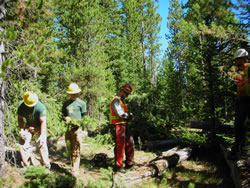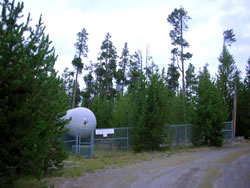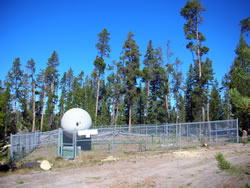
National Fire Plan Success Story
Partners Create Defensible Space in Grant Village
Yellowstone National Park, Wyoming
National Fire Plan - Fuels Reduction
2009

Montana Conservation Corps Crewmembers and Yellowstone fire staff hard at work.

Grant Village Propane Farm prior to treatment.

Grant Village Propane Farm post-treatment.
The partnership agreement with the Montana Conservation Corps (MCC) is one of the more enduring partnership agreements in Yellowstone National Park. This organization has long been involved in trail maintenance, fence construction and other projects supporting park operations. This is the third fuels reduction project they’ve accomplished in the park in the last four years. The first was at the remote Bechler Ranger Station, the second at Nez Perce cabin and this most recent project at the Grant Village development.
The Grant Village project is the most ambitious to date, totaling 48 acres and involved twenty-one crewmembers. Grant was the site of extensive suppression efforts during the 1988 fire season. While much of the western approach to the area was severely impacted by fire, most of the community remains nestled in a very heavily forested lodgepole, spruce/fir ecosystem with a significant amount of whitebark pine as well. MCC personnel, working with the guidance of park fire and forestry personnel, carefully thinned vegetation so that the age and species composition of the forest remains essentially the same, while greatly reducing the amount of biomass per acre.
A goal of the project has been to utilize 100% of the biomass produced. While some pile burning may be necessary in remote portions of some units, to date nearly 3000 corral rails and posts have been produced. The park has sold permits allowing over 100 cords of firewood to be collected, and fuels projects have generated more than 130 cubic yards of wood chips for park use. The project is ongoing, and greater results are expected as work is completed.
Yellowstone National Park management wishes to thank all participants for the effort they’ve invested in making the area safer from adverse effects of wildfire. As one MCC member put it, “I learned a lot about chainsaws and sawing, but it was a lot of hard work.” Needless to say, the park intends to utilize this vital labor force well into the future.
Contact: Andrew Mitchell, Assistant Fire Management Officer, (307) 344-2182.